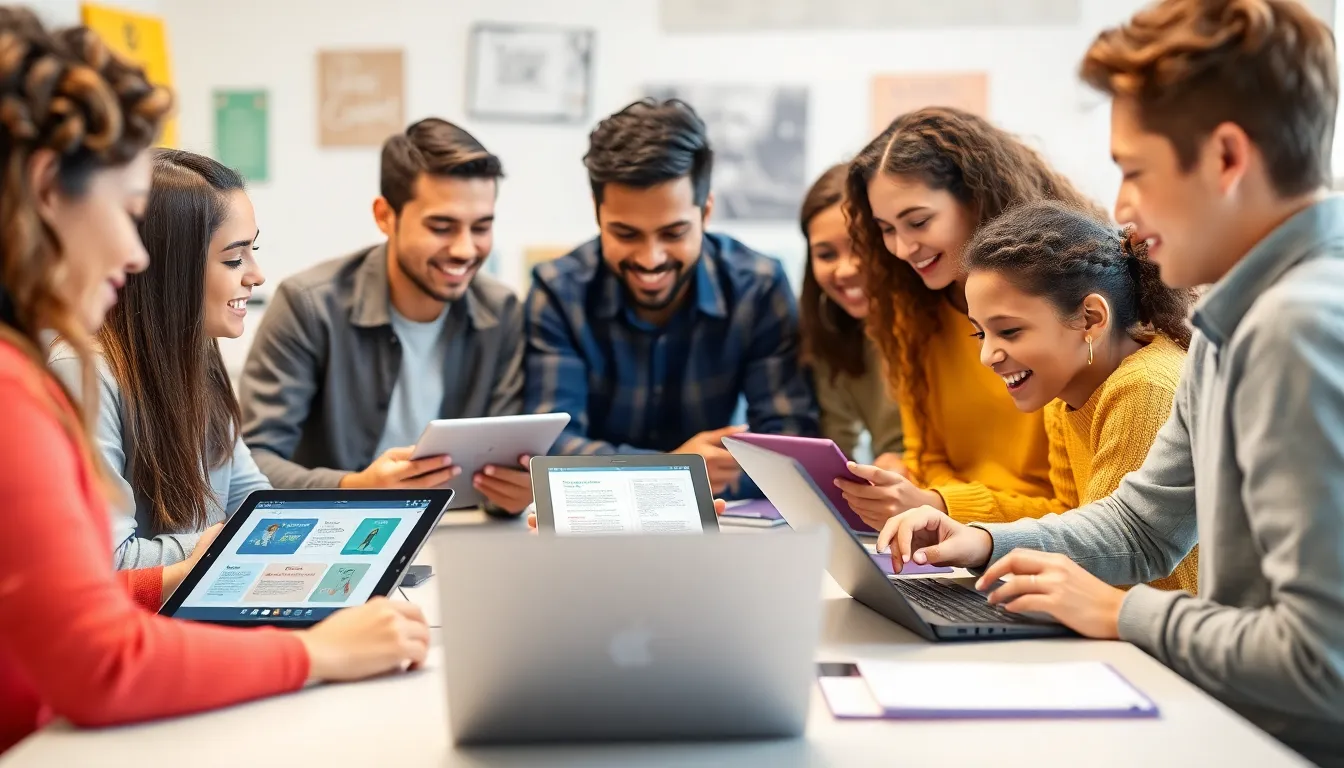In today’s tech-savvy world, students have a treasure trove of digital resources at their fingertips. Gone are the days of lugging around heavy textbooks or desperately searching for a library that’s open past noon. With just a few clicks, they can access a wealth of knowledge that’s as vast as the internet itself—and way less dusty.
From interactive learning platforms to engaging video tutorials, these resources not only make studying more enjoyable but also help students grasp complex concepts with ease. Imagine turning a dreaded math problem into a fun game or finding the perfect study buddy in a virtual study group. With the right digital tools, students can transform their academic experience from “meh” to “wow!” So let’s dive into the digital realm and explore the best resources that can help students ace their studies while having a little fun along the way.
Table of Contents
ToggleImportance Of Digital Resources For Students
Digital resources greatly expand access to learning materials, making education more inclusive. With online platforms, students access information anytime and anywhere, transcending the limitations of traditional textbooks. Interactive learning environments foster engagement, stimulating interest in subject matter through dynamic content. Video tutorials provide visual explanations, breaking down complex concepts into digestible segments.
Flexible study tools support various learning styles, enabling personalized education experiences for diverse student needs. In addition, collaborative platforms encourage communication among peers, promoting teamwork on projects. E-books often come at a fraction of the cost, reducing financial burdens associated with purchasing physical books.
Online libraries offer vast collections of academic papers and journals, facilitating research that enriches students’ understanding of topics. Educational apps target specific skills, allowing learners to practice at their own pace. Gamified learning methods transform studying into enjoyable challenges, motivating students to achieve their goals.
Utilizing digital resources enhances critical thinking and problem-solving skills, essential competencies in today’s workforce. Online courses provide opportunities to learn from experts around the globe, broadening students’ perspectives and networks. By integrating these technologies into their studies, students often find enhanced academic performance and better retention of knowledge.
Overall, the importance of digital resources for students lies in their capability to make education more accessible, engaging, and tailored to individual needs, ultimately leading to more successful learning outcomes.
Types Of Digital Resources

Digital resources offer diverse options for students, catering to different learning styles and preferences. The following sections detail popular types of digital resources that can enhance academic experiences.
E-Books And Online Libraries
E-books provide immediate access to a vast range of texts. Many online libraries offer collections covering various subjects. Students benefit from searchable content, which saves time during research. Open-access platforms enable free borrowing, reducing costs related to traditional textbooks. Notably, certain online libraries allow users to borrow multiple titles simultaneously, ensuring access to comprehensive materials.
Educational Apps And Tools
Educational apps enhance learning through interactive approaches. Many applications target specific subjects like math or language arts, fostering skill development. Productivity tools assist students in organizing their studies efficiently, while gamified apps make learning engaging and fun. Various platforms allow real-time collaboration on group projects, promoting teamwork among peers. Customized learning experiences through these apps cater to individual needs, making education more effective.
Online Courses And Tutorials
Online courses expand learning opportunities beyond traditional classrooms. Students can enroll in numerous subjects at their convenience, balancing work and study demands. Video tutorials offer step-by-step guidance for complex topics, complementing written resources. Many platforms feature assessments to track progress, helping students identify strengths and weaknesses. Certificates earned from these courses enhance resumes and highlight commitment to lifelong learning.
Benefits Of Utilizing Digital Resources
Digital resources offer numerous advantages that significantly impact students’ learning experiences. These tools foster a dynamic environment where learning thrives.
Enhanced Learning Experience
Interactive platforms engage students actively and make absorbing information easier. Video tutorials provide visual aids that clarify complex topics while offering diverse learning styles. Educational apps often include quizzes and gamified content that motivate students to study and retain knowledge. These resources encourage collaboration, allowing students to connect and exchange ideas efficiently. Personalized learning paths enhance understanding and cater to individual preferences, ultimately fostering a deeper appreciation for the subject matter.
Accessibility And Flexibility
Accessing digital resources anytime and anywhere breaks down geographical barriers. Online libraries house vast collections of texts that serve various courses and interests, enabling immediate research. Students benefit from the ability to learn at their own pace, adjusting study schedules to fit other commitments like jobs or internships. Open-access platforms further reduce costs associated with purchasing textbooks, ensuring that more learners can access essential materials. Flexibility allows students to engage with content that suits their learning styles, enhancing the educational experience.
Challenges Faced By Students
Students encounter several challenges while utilizing digital resources for their studies. The increasing reliance on technology also exposes significant issues that affect their learning.
Digital Divide
Access to digital resources isn’t equal among students. Geographic location and socioeconomic status often determine available resources. Students in urban areas frequently benefit from faster internet and better access to devices. In contrast, those in rural or low-income environments face limitations that hinder their engagement. This disparity creates significant gaps in educational opportunities. Schools often serve as critical resources, but not all institutions offer sufficient technological support. Addressing and narrowing the digital divide is essential for comprehensive education.
Distraction And Overload
Digital resources can lead to distractions and information overload. Students may struggle to focus when multiple tabs and notifications compete for attention. A wealth of information is available online, yet sifting through it can be overwhelming. This constant barrage of content can dilute learning effectiveness. Effective time management techniques are often necessary to navigate this complexity. Distractions from social media, gaming, or unrelated websites further complicate their efforts to study. Maintaining concentration in an environment filled with digital temptations proves challenging for many learners.
Digital resources have transformed the educational landscape for students. By embracing these tools, learners can access a wealth of information and engage with content like never before. The flexibility and interactivity of online platforms cater to diverse learning preferences, making education more effective and enjoyable.
While challenges like the digital divide and distractions exist, the benefits of utilizing digital resources far outweigh the drawbacks. With the right strategies in place, students can navigate these complexities and maximize their learning potential. As technology continues to evolve, staying informed about available resources will empower students to enhance their academic journeys and achieve their goals.


